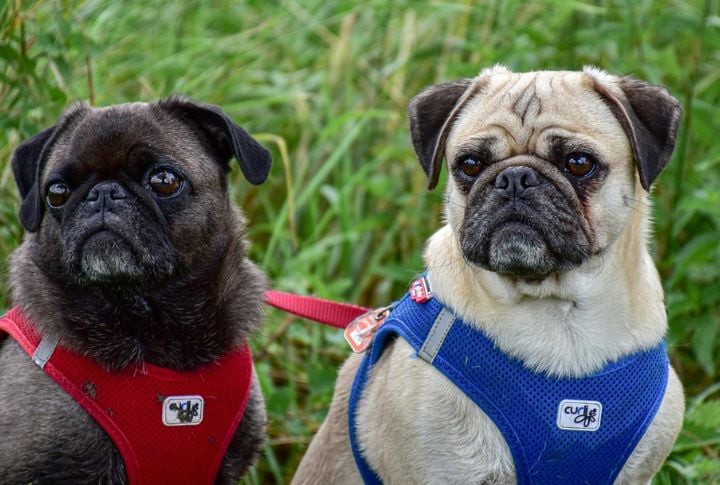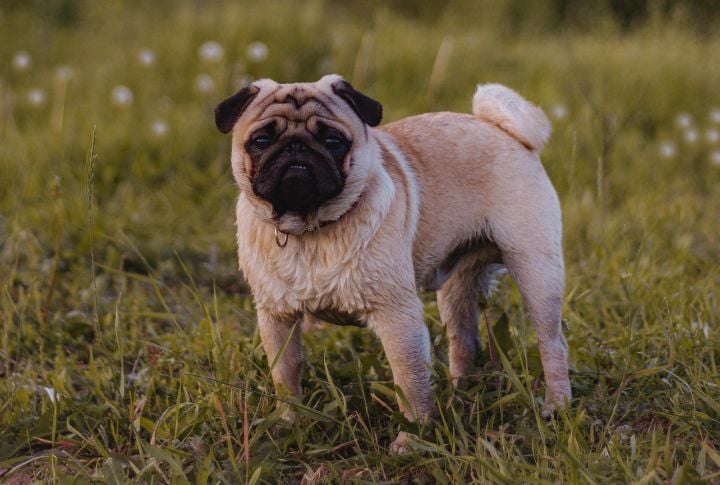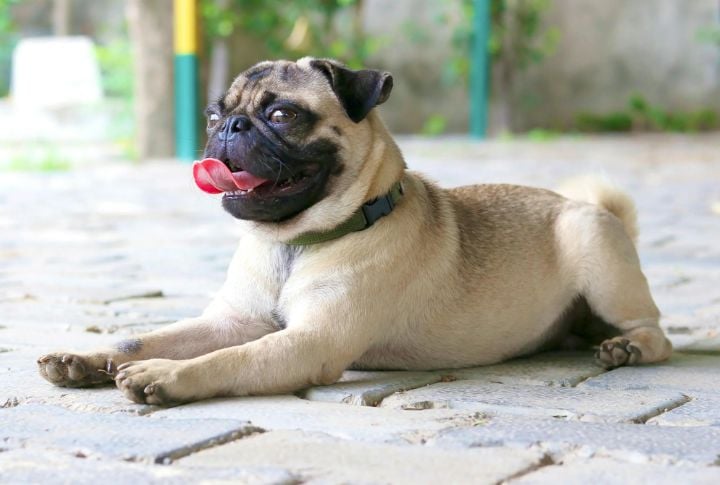15 Health Risks That Come With A Pug’s Unique Build

Pugs are charming and affectionate companions, but their unique appearance comes with several health risks. Their flat faces, curled tails, and compact bodies make them prone to specific medical issues that owners shouldn’t ignore. Here’s what you need to know about the conditions most likely to show up.
Brachycephalic Obstructive Airway Syndrome (BOAS)

The pug’s short, flattened snout puts them at serious risk for BOAS, a condition that restricts airflow. Loud breathing and difficulty exercising are common signs. Surgery is sometimes required to open airways. Furthermore, in hot weather, pugs with BOAS are at high risk of overheating, even during brief outdoor walks.
Eye Injuries And Proptosis

With bulging eyes and shallow sockets, pugs are vulnerable to corneal scratches and eyeball displacement, known as proptosis. Trauma or excessive pressure around the neck can trigger this emergency. One documented case involved a pug’s eye dislodging from pulling too hard on a leash. It’s best to use a harness and not a collar.
Skin Fold Dermatitis

Those signature facial wrinkles can trap moisture, food, and bacteria, causing painful skin infections. This condition, called skin fold dermatitis, often leads to itching and a sour smell. Left untreated, it can escalate into oozing sores requiring antibiotics or topical treatment. Daily cleaning between folds is, therefore, essential.
Hip Dysplasia

Hip dysplasia is a hidden risk in pugs, despite their compact build. This joint malformation causes improper alignment, leading to pain and arthritis. Affected dogs may limp or avoid stairs and jumping. Early signs often appear by age two, and severe cases may require surgery or lifelong joint management.
Pug Dog Encephalitis (PDE)

PDE is a fatal, breed-specific brain inflammation affecting young to middle-aged pugs. Seizures, disorientation, and behavioral changes often progress quickly. There’s no known cure, and diagnosis is typically confirmed post-mortem. Genetic testing can identify carriers, making responsible breeding the only current prevention method available.
Hemivertebrae

That charming curly tail is linked to a spinal deformity called hemivertebrae, where vertebrae are wedge-shaped and misaligned. This condition can lead to pain or even paralysis if it compresses the spinal cord. It’s particularly common in screw-tailed breeds like pugs. In severe cases, mobility issues may require surgical intervention.
Allergies

Pugs often suffer from environmental and food allergies, which can trigger chronic itching, ear infections, and digestive issues. Common culprits include chicken, beef, and grains; signs may include excessive licking or red, inflamed skin. Their short coats and wrinkled skin can make allergic reactions more noticeable and difficult to manage without veterinary help.
Obesity

This breed loves to eat and tends to gain weight easily, putting strain on their joints and breathing. Even a few extra pounds can worsen existing conditions like BOAS. A 2022 study found that 17.4% of pugs were diagnosed with obesity, and this makes them nearly four times more likely to be obese than other breeds. Precise portion control and low-impact exercise are essential.
Reverse Sneezing

This alarming, snorting episode is common in pugs and often mistaken for choking. Reverse sneezing happens when soft palate irritation causes rapid inhalation through the nose. It usually resolves on its own, but frequent episodes could signal an underlying issue like nasal mites or an elongated soft palate. Recording incidents can help with diagnosis.
Patellar Luxation

A dislocated kneecap, or patellar luxation, causes sudden limping or an odd gait. Pugs are genetically predisposed to this condition, especially in the hind legs. While mild cases may require only monitoring, severe ones need surgery. Vets report that up to 7% of pugs show signs of this orthopedic issue.
Dental Disease

Crowded teeth in a small jaw make pugs prone to plaque buildup and periodontal disease. Without regular care, this can lead to gum infections and tooth loss by age three. Bad breath is often the first sign, followed by other symptoms like a loss of appetite. Annual dental cleanings and daily brushing are needed to prevent irreversible damage.
Hypothyroidism

Hypothyroidism, a condition caused by low thyroid function, occurs less often in pugs than in other dogs. However, when it occurs, symptoms include sluggishness, hair thinning, and weight gain. Bloodwork confirms the diagnosis, and treatment usually involves lifelong medication. If untreated, the condition can escalate into skin infections and mental dullness.
Interdigital Cysts

These painful, swollen bumps appear between a pug’s toes and can rupture or become infected. They’re often caused by ingrown hairs or allergies, but may also stem from bacterial infections. A vet may drain or remove them if they are persistent. In some cases, the animal experiences recurring flare-ups that require long-term care.
Heat Intolerance

In 2024, PETA reported 111 heat-related deaths among companion animals, including pugs. These canines overheat easily due to their short snouts and compromised airways. Even moderate temperatures can cause panting and fatigue, and in extreme cases, collapse. These canines with breathing impairment are more likely to suffer from heatstroke than other dogs.
Tail Infections

Pugs with tightly curled or screw tails can develop deep tail pockets—hard-to-clean creases that trap bacteria and feces. Infections here cause redness, odor, and severe discomfort. Regular inspection and cleaning are vital. Severe cases may require tail amputation, particularly if the skin becomes chronically infected or necrotic.






